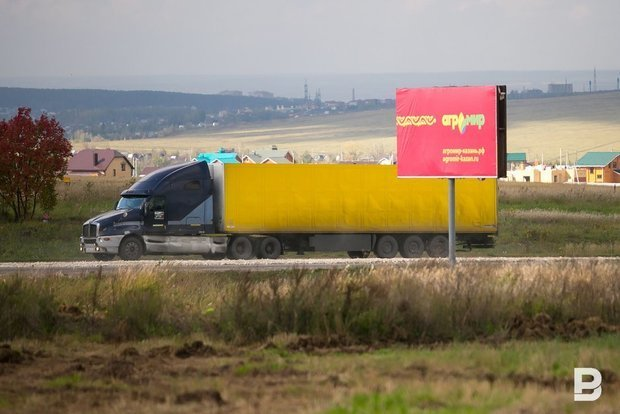Sergey Sotnikov: ‘At the moment we have what to drive, but what will happen in a year or two, five years?’
An expert about the transformation of the logistic market and the serious dependence of transporters on import

Cargo transportation in Russia rose by 7% in Russia last year. If the market suddenly shrank in spring, by the beginning of winter, in contrast, it added up 24%. Freight delivery from Kazakhstan and Belarus where volumes increased by more than a third are leaders in number of orders. At the same time, exports stayed at the level of 2021, mainly thanks to friendly countries. Volumes of Russian cargo to China, Armenia and Georgia almost doubled. However, the imposition of anti-Russian sanctions anyway had a negative impact on logistics, noted Chairman of the Committee for Logistics and Cargo Transportation of the Tatarstan Chamber of Commerce and Industry Sergey Sotnikov. In an op-ed column for Realnoe Vremya, the expert explains that the abundance of import lorries is the culprit as well as the dependence of Russian car manufacturers from imports.
Cargo transportation business quickly readjusted
Automobile carriers always worked in harsh market conditions, not receiving any support from the state. They survived thanks to their own initiatives and hard work despite any crisis that seized the country, in 1998, 2008 or 2014. Of course, there were declines last year, which was tough too: they had to change logistic routes leaving western destinations to eastern and southern — the Far East, Caucasus, Turkey, Novorossiysk, Middle Asia. They looked for ways to deliver spare parts.
As for transportation in Russia, nothing really changed here — the volume of transportation didn’t suffer significant losses. This is why, fortunately, we cannot say that everything is critically bad. We work and do not see any serious bankruptcies of logistic companies — this business readjusted.

By the way, cargo transportation includes not only automobiles: railway transport accounts for up to 20% of the total amount of cargo transportation. Today this sphere has a very huge load, we can say it is working beyond its limit because so much cargo is coming from the Far East. The railway road crossing the whole country was built in the USSR, but unfortunately the infrastructure hasn’t seriously developed in new Russia — there haven’t been built new roads in nearly 40 years. This is why today we have very weak railway infrastructure — the weakest link in logistics.
Some railway stations and hubs cannot simply physically cope with the amount of cargo transportation. For instance, here it is Zakamye region, the local railway hub isn’t designed for contemporary flows. There is the only single track built in the Union, it hasn’t changed, though the necessity of increasing its throughput has been discussed for decades. Plus, the infamous optimisation that has been done for many years makes itself known. It is good railway transportation works, freight is shipped, the country hasn’t stopped.
“No matter the label, the dependence on imports is plain to see”
Imported components of lorries is one of the main problems in the sector today. Cargo transportation has troubles, the problems are understood too. Now it is necessary to choose a contractor: who will really start the production and who will just speak. Results of import substitution have been reported successfully in the country for many years, but in the end almost nothing has been replaced. However, there were so beautiful projects, presentations, red ribbons were cut. And all of a sudden it became a revelation for everybody that Russian lorries were assembled from imported components. Once, I don’t know who made this decision, the whole transport sector started to depend on foreign lorries and spare parts. And no matter what Russian producers told us, a lion’s share of spare parts in cars is imported, no matter the label, the dependence on imports is plain to see.
The fact that all foreign lorry producers have exited Russia is bad for transportation. We need to service these lorries, we need spare parts for them. Thank God, some commercial enterprises that managed to set up their supply from third countries. But this led to significant appreciation of spare parts, which ultimately influenced the price of transportation — they rose by at least 20% over the year. This includes not only the price of spare parts but also constantly rising fuel price, the higher price for the vehicles themselves. In the end, the consumer pays for everything — hence growing prices for food, clothes and other products.
Facing all these problems every day, we would like to know what exit from this situation the state sees. The dependence on imported lorries and spare parts isn’t about transport security. We won’t be able to transport goods and the economy will simply stop without lorries — a railway wagon won’t reach every store or enterprise. Automobile transportation account for about 70% of all cargo shipping. And the more expensive the lorries, the more expensive transportation, the price of products. If everybody is happy about such a state of affairs, the growth will be constant.

Why is a lorry from China cheaper than a Russian one?
Tractor trailers, somebody calls them Euro trailers, are mainly used for intercity transportation. Approximately 90% of 2.5 million of those vehicles are used by Russian logistic companies are of foreign origin. Yes, there are KAMAZ lorries, but their share is very insignificant. If we take construction vehicles — dumper trucks, here the share of KAMAZ lorries is quite considerable — 50% and more.
Foreign dumper trucks also have a limited service life, they need to be upgraded every year, which means that tens of thousands of lorries need to be replenished a year. At some point, any machinery goes out of service and it had to be pensioned off or disposed of. At the moment we have what to drive, but a logical question comes about — what will happen in a year or two or five years, what will companies transport cargo with? Those tractor trailers KAMAZ provides — about 2.000 lorries — are obviously not enough nationwide. We need tens of thousands of vehicles to replace import transport.
Supplies of Chinese lorries have increased in the Russian market now. Interestingly, considering customs and other duties, recycling fees, shipping, which is, by the way, isn’t cheap, the cost of a lorry from China is 9 million rubles. To compare, buying a KAMAZ will cost almost 11 million rubles, though in 2015-2016 it cost about 3 million rubles. Though logically, Russian machinery should be cheaper than the one that has to be brought from the far away. Does it mean that something is wrong here if a vehicle from China is cheaper than a Russian one? Again, the presence of imported spare details in the Chelny lorry plays a role, though not a good one. The company has such big production capacities, so much money, state support — so make your own brake pads or filters to start with! Why do they continue using a mass of Chinese spare parts or bring from somewhere else? Moreover, this applies to all Russian manufacturers. And I think this situation is a serious challenge for our country.

The rise of the Russian mechanical engineering sector has been discussed for 30 years. But the thing is that everybody wants a quick and beautiful picture. Even three months haven’t passed since the exit of foreign companies, we have already made a new Moskvitch. What’s in fact? Again, it is a Chinese car. Look at the beautiful cabin, though it is a Mercedes cabin. Quickly and impressively.
Talking about the forecasts for this year, we stick to the golden rule — to believe in the best, prepare for the worst, then you will survive. A business isn’t run with rosy glasses on. Most importantly, we have saved the staff, people are still optimistic, they want to keep working.
We want the state to create conditions to develop a business, and if the country really develops the production and the industry, we will always have what to transport. Everything that’s happening now is our new opportunities we can and should take advantage of. Most importantly, we need people who want and can work.
Reference
The author’s opinion does not necessarily coincide with the position of Realnoe Vremya’s editorial board.